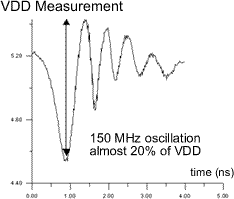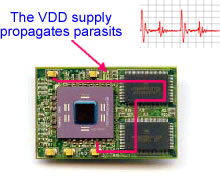| CMOS Design |
The inverter consumes power during transitions, due to two separate effects. The first is short circuit power arising from momentary short-circuit current that flow from VDD to VSS when the transistor functions in the incomplete-on/off state. The second is the charging/discharging power, which depends on the output wire capacitance. With small loading, the short circuit power loss is dominant. With a huge loading, i.e a large output node capacitance, the loading power is dominant. The power consumption occurs briefly during transitions of the output, either from 0 to 1 or from 1 to 0.
The transient current peaks appear at each modification of the output voltage, as shown in the figure. The simulation contains the supply currents in the upper window, and all voltage waveforms in the lower window. The current consumption is important only during a very short period corresponding to the charge or discharge of the output node. Without any switching activity, the current is very small.

Inverters consume power during transitions (momentary short circuit and C charge)
For one inverter 0.2mA => May reach 100A peak on VDD in ultra complex circuit


| CMOS Design > Inverter > Inverter Power Consumption |